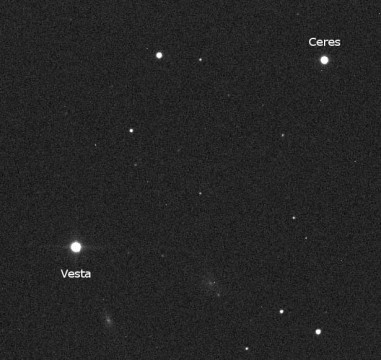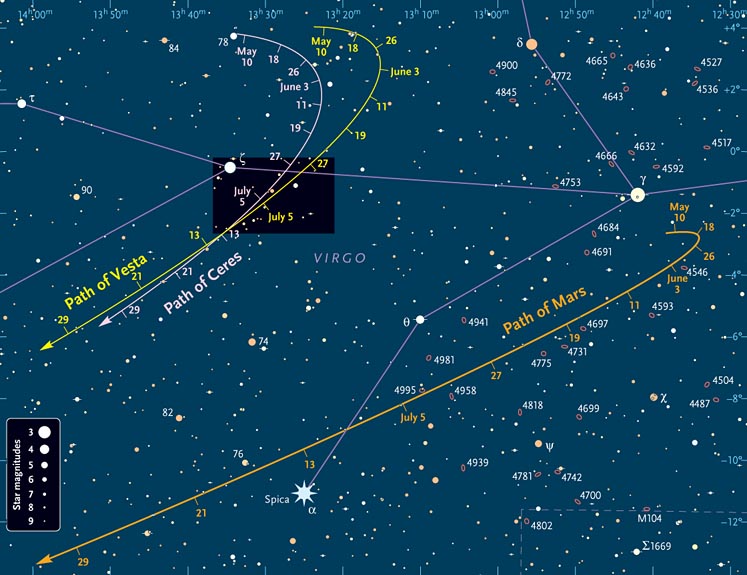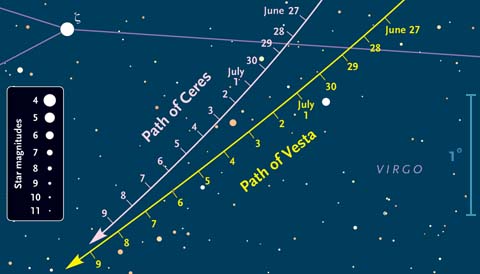It's rare that two sizable asteroids pair together in the sky as closely as Ceres (the biggest of all) and Vesta (the brightest) in early July.

Gianluca Masi / Virtual Telescope Project
For the past few months, two of the biggest and brightest asteroids — 1 Ceres and 4 Vesta — have been gliding in parallel just 2° or 3° apart in eastern Virgo. They've been visible in binoculars all that time and gradually drawing closer together in the sky.
This week their months-long dance reaches its denouement, as the king and queen of the asteroid belt appear to embrace closer than anyone has ever seen them. They'll appear just 10 arcminutes apart (a third of the Moon's apparent diameter) on the evenings of July 4th and 5th in the Americas (July 5th and 6th Universal Time). They'll remain near one another for the next few weeks, separated by 2.2° on August 1st and by 5° on September 1st.
How to Spot Ceres and Vesta Tonight
If you've always wanted to view an asteroid, this is a great opportunity. Right now the Ceres-Vesta pairing is moderately high in the southwest at nightfall (30° high if you're near 40° north latitude), so you'll have time to track them down shortly after twilight ends before they become too low.
Mars and the star Spica are your starting points, as shown on the wide-field chart below. This planet-star pairing has been tightening as well: they're 5½° apart on July 1st and just 1.3° apart on July 13th, the date when they appear closest together. They'll be joined on the evening of July 5th by a just-past-first-quarter Moon that skirts especially close to Mars.

Sky & Telescope diagram
Look 10° above the planet-star combo — the width of your fist on an outstretched arm — to find the 3rd-magnitude star Zeta (ζ) Virginis, also known as Heze. It's the faint peak of a narrow, wizard-hat-shaped triangle with Mars and Spica at its base. Ceres and Vesta are inside that triangle, situated roughly side by side and just 1½° below (southwest of) Zeta.

Sky & Telescope diagram
If you carefully note the asteroids' positions, you should be able to monitor their night-to-night motion (likewise about 10 arcminutes) with respect to the surrounding stars.
These two "dwarf planets" were brightest when at opposition back in April, and since then they've lost some luster. In early July, Ceres is magnitude 8.5 and brighter Vesta is 7.2. And yet Ceres, with a diameter of 585 miles (940 km), is nearly twice as large as Vesta. It looks fainter partly because it's farther away — 46 million miles (74 million km) beyond Vesta on July 5th — and because it's farther from the Sun as well. So, while they look close together in the sky, they're really not.
Ceres also has a much darker surface. Vesta is medium gray, reflecting 42% of the sunlight striking it (a high albedo, or reflectivity, for an asteroid), while Ceres is a more typical dark gray-brown with an albedo of only 9%.
If it's cloudy or you don't have a telescope handy, you can watch the pairing of Ceres and Pallas online. Choose between Slooh's webcast (which begins July 3rd at 8 p.m. Eastern Daylight Time) or Gianluca Masi's Virtual Telescope Project (July 5th at 4:00 p.m. EDT).
Quite near the two asteroids on the sky, though utterly invisible, is NASA's Dawn spacecraft. It's en route from its successful 2011-12 mission at Vesta to its next mapping project at Ceres, where it will take up permanent orbit next March. Hubble images reveal Ceres to have a patchwork of bright and dark markings — hints of interesting landscapes awaiting Dawn.
Keep tabs on major celestial happenings throughout the year with SkyWatch 2014.
 10
10
Comments
Chris-Schur
July 1, 2014 at 11:21 am
cmon, is Vesta "really" a dwarf planet? Nice article however, I will go out and look at this one.
Chris
You must be logged in to post a comment.
July 6, 2014 at 1:44 am
Vesta gets a bum rap because it isn't quite round (anymore) Something about a bad accident during the Late Heavy Bombardment, I think. But it IS differentiated, perhaps more than Ceres.
I had the pleasure to show this extraordinarily close pairing to about 15 attendees to our public Star Party earlier this evening, surprisingly easy to find in a small scope, even under a bright Moon nearby. - Thanks Alan!
You must be logged in to post a comment.
July 6, 2014 at 9:16 am
The boundaries between asteroids, dwarf planets, major planets, and brown dwarfs are inherently fuzzy. I think both Mike Brown and Alan Stern understand this, even though they like to argue in public.
You must be logged in to post a comment.
Anthony Barreiro
July 1, 2014 at 2:51 pm
Alan, I don't understand why you call Ceres and Vesta "the king and queen of the asteroid belt". Ceres and Vesta are goddesses in Greek and Roman mythology. Why would Ceres, the goddess of agriculture and fertility, have to cross-dress to play a king?
Would you call Jupiter and Saturn "the king and queen of the planets"?
You must be logged in to post a comment.
David-Bartley
July 4, 2014 at 9:26 am
Could you please give the coordinates for Vesta and Ceres for July 4 and 5?
You must be logged in to post a comment.
J. Kelly Beatty
July 5, 2014 at 8:56 am
hi, David... here are positions for the next few nights. note that these times are for 0h UT, which corresponds to 8 pm EDT the previous evening:
1 Ceres R.A. Dec.
2014 07 06 13 31 21.5 -01 45 40
2014 07 07 13 31 57.1 -01 54 12
2014 07 08 13 32 33.7 -02 02 48
2014 07 09 13 33 11.4 -02 11 26
4 Vesta
2014 07 06 13 31 14.9 -01 55 30
2014 07 07 13 32 07.7 -02 05 23
2014 07 08 13 33 01.7 -02 15 21
2014 07 09 13 33 56.9 -02 25 23
You must be logged in to post a comment.
David-Bartley
July 5, 2014 at 3:43 pm
Thanks. Do you realize that Cartes du Ciel is about 3 min off in RA?
You must be logged in to post a comment.
jim pryal
July 4, 2014 at 5:46 pm
Thanks for the Heads Up, I've been watching the pair from June 29th thru July 1. Anyone know how long it has been since these two have been this close in earth's skies?
Jim Pryal
You must be logged in to post a comment.
Anthony Barreiro
July 5, 2014 at 1:45 pm
Jim, I've been watching them too. I've read that this the closest Ceres and Vesta have ever been in the sky since they were discovered over 200 years ago.
You must be logged in to post a comment.
Fred Espenak
July 7, 2014 at 11:08 pm
Hi Alan - I had five clear nights in a row before Arizona's summer monsoon kicked in on July 3. So I was able to shoot Vesta and Ceres through my ASA 12-inch every night from June 27 through July 2. The composite image from all five nights is posted at:
http://astropixels.com/conjunctions/2014/VestaCeres14-01.html
When you run your cursor/mouse over the image, labels pop-up identifying Vesta and Ceres along with the dates. It was a fun project and I only regret not having a few more clear nights.
- Fred Espenak
You must be logged in to post a comment.
You must be logged in to post a comment.